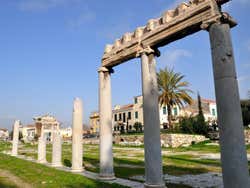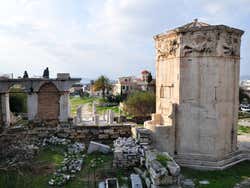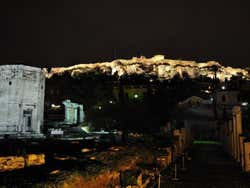
Roman Agora
The Roman Agora was the ancient public square raised during the Roman period in Athens. It was one of the main meeting points in the city and it once housed the central market.
The Roman Agora is found on the north side of the Acropolis, in the charming neighborhood of Plaka. It is located a short walk away from the Ancient Agora, which is larger and more spectacular. The public square was established during first century BC.
History
The experts believe that the Roman Agora was first founded between 19 BC and 11 BC. It was commissioned by the first Roman Emperor Augustus and then enlarged by the Emperor Hadrian.
During its golden age, the Agora was a type of courtyard that measured 100 square meters. It was home to the central market, which had been moved from the Ancient Agora. The public latrines were located on the east side of the square.
The open space was surrounded by a marble Ionic colonnade and the patio was also completely covered in marble. There were two propyleas (gateways), the main one was on the west and the other was on the east.
Present Day
Currently, only a small portion of the columns are still standing, and the remains of the public outhouse.
The “Tower of the Winds”, found on the western side of the Agora, is practically intact. This polygonal monument sheathed in marble slabs was built during the second century BC and was used as a water clock and sundial. The building remained intact because it was transformed into a chapel during the sixth century.
The Roman Agora is still not fully excavated, but with a bit of imagination, visitors can get a sense of how lively this public square was once.



Schedule
From April to August: 8:00 a.m. to 8:00 p.m.
Rest of the year: 8:00 a.m. to 3:00 p.m.
Price
Adults: € 8 (US$ 8.80).
Seniors over 65 and young people under 25: € 4 (US$ 4.40).
Combined ticket: € 30 (US$ 33.01).
The combined ticket includes the Roman Agora, the Acropolis, the Olympieion, Hadrian's Library, the Kerameikos, the School of Aristotle, and the Ancient Agora.
Transport
Metro: Monastiraki, lines 1 and 3.
Nearby places
Museum of Greek Folk Musical Instruments (85 m) Hadrian's Library (138 m) Kanellopoulos Museum (142 m) Anafiotika (239 m) Monastiraki (258 m)

